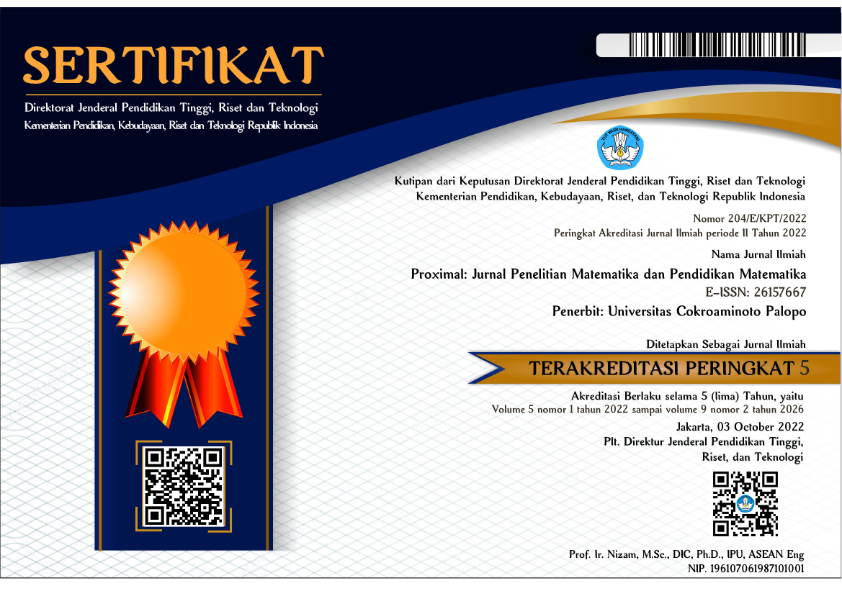Analisis Pemodelan Matematika dalam Menentukan Strategi Optimasi Laba pada UMKM Keripik Tahu Yuka
DOI:
https://doi.org/10.30605/proximal.v8i4.6407Keywords:
Profit Optimization, Mathematical Modeling, Linear Programming, MSMEs, Soybean-Based ProductsAbstract
Setiap pelaku usaha, termasuk Usaha Mikro Kecil dan Menengah (UMKM), tentunya ingin memperoleh keuntungan maksimal. Namun, seringkali produksi dilakukan tanpa pertimbangan proporsional terhadap permintaan pasar, yang dapat menyebabkan kelebihan produksi dan kegagalan mencapai laba optimal. Penelitian ini berfokus pada UMKM Keripik Tahu Yuka di Kota Magelang, yang memproduksi berbagai olahan kedelai seperti tahu pong, keripik tahu, pilus tahu, dan rolade tahu. Tujuan penelitian adalah untuk menentukan jumlah produksi optimal dari masing-masing produk guna memaksimalkan laba melalui penerapan model matematika berupa pemrograman linier. Data primer dikumpulkan melalui wawancara semi terstruktur dengan pengelola UMKM, yang mencakup data bahan baku, biaya produksi, harga jual, dan permintaan pasar. Model pemrograman linier yang disusun diselesaikan menggunakan perangkat lunak POM-QM for Windows. Hasil penelitian menunjukkan bahwa untuk mencapai laba maksimum sebesar Rp 2.604.114,00 dalam satu hari, UMKM Keripik Tahu Yuka disarankan untuk memproduksi 291 pak tahu pong, 150 pak keripik tahu, 250 pak rolade tahu, dan 20 pak pilus tahu.Downloads
References
Dwikasari, L. G., Pawestri, S., & Rasyda, R. Z. (2024). Pemodelan Matematika dalam Optimasi Laba Produksi Olahan Rumput Laut di UD Harkat Makmur. Jurnal Kolaboratif Sains, 7(6), 1942–1953. https://doi.org/10.56338/jks.v7i6.5371
Hartama, D., Andini, S. R., Aningke, T., Pradana, Y., Ayu, E. M., & Solikhun. (2020). Riset Operasi Optimalisasi Produksi Menggunakan Metode Simpleks dan Metode Grafik. Pematangsiantar: Yayasan Kita Menulis.
Hidayah, A. A., Harahap, E., & Badruzzaman, F. H. (2022). Optimasi Keuntungan Bisnis Bakery Menggunakan Program Linear Metode Simpleks. Jurnal Matematika, 21(1), 77–83.
Hillier, F. S., & Lieberman, G. J. (2015). Introduction to Operations Research (10th ed). McGraw-Hill Education.
Jalil, E., & Irwan, M. (2019). Pemodelan Matematika Dalam Sistem Massa Pegas Dengan Massa Tidak Konstan. Jurnal Matematika Dan Statistika Serta Aplikasinya, 7(2).
Juliasari, W., Azzahra, B. S., Ginting, F. Q., & Nurmufida. (2025). PERANCANGAN PRODUKSI DENGAN MENGGUNAKAN METODE SIMPLEKS UNTUK MENDAPATKAN KEUNTUNGAN (STUDI KASUS ME’NATE STEAK HUB JOHOR BAHRU). JURNAL MANAJEMEN AKUNTANSI DAN ILMU EKONOMI, (1). Retrieved from https://jurnal.ananpublisher.com/index.php/jumali
Meflinda, A., & Mahyarni. (2011). Riset Operasi. Pekanbaru: UNRI PRESS.
Palahudin, P., Aura Ginta Setia, Siti Nadya Safira, Safira Seftiyani, Muhamad Nauval Ardani, & Muhammad Fiqih. (2025). Optimalisasi Keuntungan Produksi Makanan Olahan Mie Mengunakan Metode Simpleks. Profit: Jurnal Manajemen, Bisnis Dan Akuntansi, 4(1), 213–227. https://doi.org/10.58192/profit.v4i1.2975
Palahudin, P., Fauziah, F., Adam, A., Kurnia, M. S., Azzahra, F., & Salibi, I. M. (2025). Penggunaan Program Linier dengan Metode Simpleks untuk Mengoptimalkan Keuntungan Usaha Bolu. Jurnal Publikasi Manajemen Informatika, 4(1), 44–54. https://doi.org/10.55606/jupumi.v4i1.3620
Palahudin Palahudin, Hilda Sapitri, Nurul Aulia Fitriani, Mefi Septinis Zega, Ramadhani Ramadhani, & Muhamad Ikbal Fadilla. (2025). Menentukan Keuntungan Maksimal dengan Menggunakan Program Linier Metode Simpleks pada Produksi Roti Isi Cokelat Keju dan Cokelat Kacang. Trending: Jurnal Manajemen Dan Ekonomi, 3(1), 437–451. https://doi.org/10.30640/trending.v3i1.3884
Rumetna, M. S., Lina, T. N., Sahetapy, R., Saharun, R., & Langgi, O. (2025). Penerapan Metode Simpleks Berbasis Teknologi Informasi untuk Optimalisasi Keuntungan Kios di Pasar Modern. CBIS JOURNAL, 13(01). Retrieved from http://ejournal.upbatam.ac.id/index.php/cbishttp://ejournal.upbatam.ac.id/index.php/cbis
Sunaryo, Y., Solihah, S., & Yulisma, L. (2023). Buku Ajar Program Linear. Ciamis: Perkumpulan Rumah Cemerlang Indonesia.
Sundari, N., Febriyanti, P. S., Lukmana, L., Apriyanti, B., & Cristin, F. Z. (2022). Optimalisasi Keuntungan Ayam Geprek Menggunakan Pemrograman Linear Metode Simpleks. Jurnal Pustaka Aktiva, 2(1), 1–6.
Widowati, & Sutimin. (2007). Buku Ajar Pemodelan Matematika. Universitas Diponegoro.
Downloads
Published
How to Cite
Issue
Section
License
Copyright (c) 2025 Muhammad Irvan Ardianto, Nita Amalia, Madiyatu Zulfa, Yesi Franita

This work is licensed under a Creative Commons Attribution 4.0 International License.
In submitting the manuscript to the journal, the authors certify that:
- They are authorized by their co-authors to enter into these arrangements.
- The work described has not been formally published before, except in the form of an abstract or as part of a published lecture, review, thesis, or overlay journal.
- That it is not under consideration for publication elsewhere,
- That its publication has been approved by all the author(s) and by the responsible authorities – tacitly or explicitly – of the institutes where the work has been carried out.
- They secure the right to reproduce any material that has already been published or copyrighted elsewhere.
- They agree to the following license and copyright agreement.
License and Copyright Agreement
Authors who publish with this journal agree to the following terms:
- Authors retain copyright and grant the journal right of first publication with the work simultaneously licensed under Creative Commons Attribution License (CC BY 4.0) that allows others to share the work with an acknowledgment of the work's authorship and initial publication in this journal.
- Authors are able to enter into separate, additional contractual arrangements for the non-exclusive distribution of the journal's published version of the work (e.g., post it to an institutional repository or publish it in a book), with an acknowledgment of its initial publication in this journal.
- Authors are permitted and encouraged to post their work online (e.g., in institutional repositories or on their website) prior to and during the submission process, as it can lead to productive exchanges, as well as earlier and greater citation of published work.















